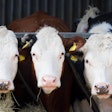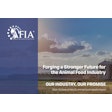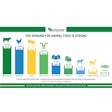
The history of feeding alfalfa to swine in the U.S. is a testament to the evolution of livestock nutrition and the agricultural industry. Alfalfa is a legume known for its protein-rich concentration among other beneficial properties. It has played a significant role in swine nutrition over the years, contributing to improved animal health and production, but it is largely neglected today.
Early usage of alfalfa in swine feeding
The history of feeding alfalfa to swine dates back to the late 19th and early 20th centuries when the U.S. was undergoing significant changes in agriculture. At that time, alfalfa was already a well-established forage crop in the country. In the form of hay, it was primarily used for feeding horses and cattle, with relatively limited application in swine diets.
In contrast, swine were often seen grazing lush pastures of alfalfa as a means of completing their diets, which were not formulated to contain all required nutrients, as is the norm today. The reasons that favored this practice included:
- Nutritional properties: Alfalfa's high protein concentration and overall rich nutrient profile made it an attractive option for swine farmers looking to enhance the quality of their pigs. This period saw the beginning of controlled experiments to study the nutritional benefits of alfalfa for swine. We must also keep in mind that linseed meal was the "oil meal" of those times when soybean meal was not the norm yet.
- Improved growth rates: Farmers who incorporated alfalfa grazing into their swine feeding programs observed improved growth rates and better feed conversion efficiency. Swine fed with alfalfa displayed enhanced muscle development, which was highly desirable for pork production. At the time, intramuscular fat or rather the lack thereof was not an issue in swine. In fact, quite the opposite was true.
- Disease resistance: Alfalfa's composition was found to bolster overall swine health, making pigs less susceptible to diseases, at least according to testimonies. This contributed to better overall herd health and reduced veterinary costs. Perhaps this was an effect of balanced nutrition or due to the many functional nutrients found in alfalfa.
The mid-20th century and beyond
During the mid-20th century, the practice of feeding alfalfa to swine lost momentum. Farmers began to appreciate the importance of balanced diets, but pigs were now housed indoors in modern facilities, whereas even the last of the unknown vitamins (B12) was discovered.
This allowed the creation of simple corn-soy diets with everything else being added at the feed mill in premixed form. Nevertheless, this era also saw the development of processed alfalfa products, such as alfalfa pellets and alfalfa meal, which made it more convenient for farmers to incorporate alfalfa into swine rations.
These ingredients were too expensive to be used, however, and their use remained a traditional recipe. Some alfalfa products were used as a fiber source for gestating sows, but less expensive ingredients prevailed too.
Now, pigs are invariably fed diets without alfalfa. In fact, such a notion is not even taught at agricultural courses, and alfalfa has been classified as a ruminant feed ingredient.
Future alfalfa usage in swine diets
This brings us to the modern era with new trends and labels that dictate how we must feed animals. Sustainability, climate change, antibiotic-free, high-fiber diets, new genetics with almost zero marbling, and a host of other challenges plague the swine industry.
Can alfalfa play a role here? The answer is clearly yes. Here's why:
- Using alfalfa pellets is the only way to get alfalfa into modern diets. They need to be ground, just like any cereal, and they can be incorporated into any swine diet. Pigs will readily accept such diets as if the aroma and taste of alfalfa is something missing from their feeds.
- The fiber profile of this old-time ingredient needs to have a second look. Alfalfa’s phytoestrogens, antioxidant phenols and other compounds can offer new advantage points and should no longer be evaluated based on its traditional nutrient profile.
- Alfalfa pellets are a readily available commodity, and they can be priced reasonably enough to use in swine diets. In contrast, traditional fiber-rich ingredients such as wheat bran — where competition from other species remains fierce — are no longer as desirable as they were in the past.
- Alfalfa protein concentrate remains an excellent idea and can provide added value to an existing commodity. Such uses as a concentrated form of amino acids in diets for young animals, like piglets, broilers and calves, is a sure bet. In addition, there might be a role to be played in otherwise far-reaching fields such as aqua and pet foods.
- As sustainability and environmental concerns become more prominent, alfalfa's ability to fix nitrogen and enhance soil health could make it an even more attractive crop for farmers. This can only mean greater availability and reduced cost.
The history of feeding alfalfa to swine in the U.S. reflects the agricultural industry's ongoing pursuit of optimizing animal nutrition and production. From its early usage as a staple protein source to its current historic status, we can see evidence of how nutrition and the animal industry continues to evolve.
Reevaluate alfalfa in modern swine nutrition, not only for its nutrients, but for a host of other components that can make alfalfa a trendy commodity for swine feeding again.


















